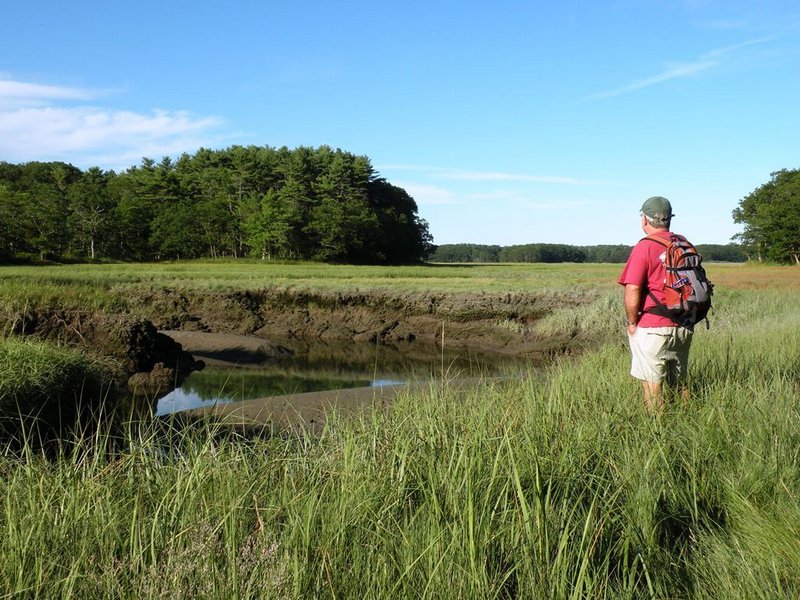The Rachel Carson National Wildlife Refuge comprises 10 geographic units ranging along 50 miles of the Maine coast from Kittery to Cape Elizabeth. These areas protect a wide variety of habitats important to migratory birds and other wildlife, and include tidal estuaries, salt marshes, barrier beaches and dunes, coastal meadows, rocky coast and forested uplands.
The 5,400-acre refuge, established in 1966 with assistance from the state, is managed by the U.S. Fish & Wildlife Service. Originally known as the Coastal Maine National Wildlife Refuge, it was renamed in 1969 in honor of Rachel Carson, the world-renowned marine biologist, environmentalist and author of five books, including the groundbreaking work, “Silent Spring.” For this she is credited with launching the contemporary environmental movement in America.
The Brave Boat Harbor Division of RCNWR in Kittery Point encompasses 700 acres of salt marsh and estuary habitat as well as oak and pine forests and old field uplands in and around Brave Boat Harbor, Cutts Island and Raynes Neck. Here, the Cutts Island Trail system makes a fine loop of two miles through this scenic and diverse landscape.
From the trailhead on Seapoint Road (information kiosk and pit toilets), the path follows the east side of Chauncey Creek, which separates both Cutts and Gerrish islands from the mainland. Saunter through mixed woods that feature some impressive old white and red oaks, white pines and cherries.
About halfway along, an out-and-back spur trail leads to an overlook. On the walk there, after passing through an old stone wall, the land narrows and salt marshes can be seen through the trees on both sides of the trail. Step off the path to the edge of the woods on the left for unobstructed views up and down Chauncey Creek. The spur ends with a nice view north over the marshes to the waters of Brave Boat Harbor.
Salt marshes like this one are transitional zones between the land and the salty or brackish waters, and teem with the wildlife that feed on the nutrients carried in on the twice-daily tides. Salt marshes help protect the coastline from storms and erosion, trap sediments and cycle nutrients, and function as nurseries for fish.
Return to the main loop trail and continue, passing by more big pines, oaks and cherry trees, a cool hemlock grove, and just off the trail on the margin of another marsh, a huge red oak that is close to 5 feet in diameter. It’s worth a few moments to explore this old soldier of a tree. Beyond, the trail trends easily downhill back to the start.
The Cutts Island Trail system is open year-round for foot traffic only from sunrise to sunset. Dogs are not allowed. Save some time for a side trip to nearby Fort McClary, which has guarded the Piscataqua River at the entrance to Portsmouth Harbor for more than 275 years.
For hikers looking to explore the RCNWR further, there are several other trails that will be of interest. The most popular is the Carson Trail in Wells, a one-mile loop that winds along Branch Brook and the Merriland River with 11 interpretive stations en route. The trail is accessible throughout, and dogs on leash are welcome. The Timber Point Trail in Biddeford winds through a 97-acre preserve along the Little River. At low tide, hikers can cross over to the 13-acre Timber Island just offshore. The Bridle Path, Goosefare Brook Trail and Atlantic Way, and Ted Wells Trail are short hikes in Kennebunk, Saco and Old Orchard Beach respectively.
For more information and trail maps, contact the RCNWR at www.fws.gov/refuge/rachel_carson or call 646-9226. You may also visit the refuge headquarters at 321 Point Road in Wells, open on weekdays from 8 a.m. to 4:30 p.m. For more info on Fort McClary, visit www.parksandlands.com or call 384-5160.
Carey Kish of Bowdoin is an award-winning member of the New England Outdoor Writers Association. Send comments and hike suggestions to:
maineoutdoors@aol.com
Send questions/comments to the editors.



Success. Please wait for the page to reload. If the page does not reload within 5 seconds, please refresh the page.
Enter your email and password to access comments.
Hi, to comment on stories you must . This profile is in addition to your subscription and website login.
Already have a commenting profile? .
Invalid username/password.
Please check your email to confirm and complete your registration.
Only subscribers are eligible to post comments. Please subscribe or login first for digital access. Here’s why.
Use the form below to reset your password. When you've submitted your account email, we will send an email with a reset code.